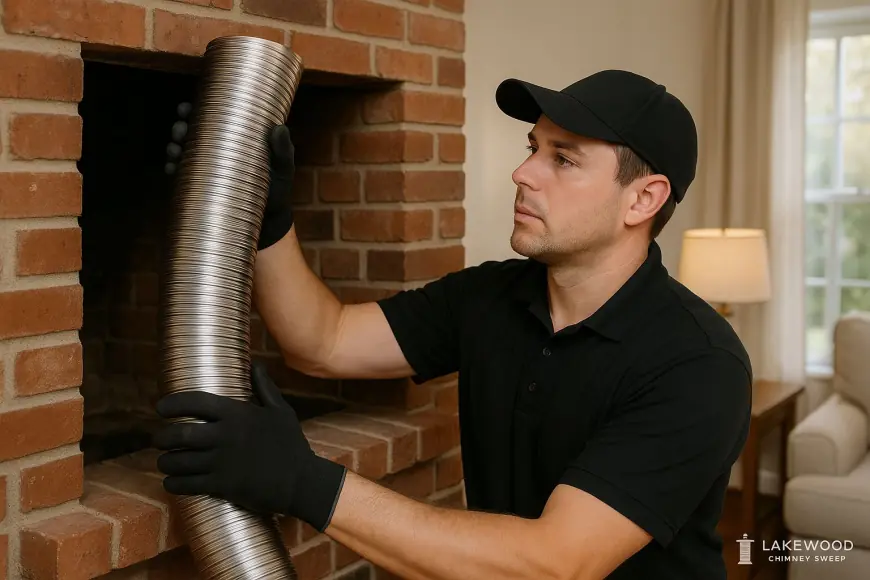How Often Should You Replace a Chimney Liner Lakewood?
Get reliable Chimney Liner services in Lakewood to protect your home. Safe, efficient, and affordable solutions for long-lasting chimney safety.

If you own a home in Lakewood, you probably know that taking care of your fireplace and chimney is more than just sweeping out ashes. One thing that often gets overlooked is the actual lining inside your chimney. This hidden tube is absolutely crucial for keeping your home safe and your fireplace running smoothly. But how do you know when it’s time to swap it out for a new one? Let’s break down how often you should consider replacing your Chimney Liner.
Key Features Of Chimney Liner: What Does a Chimney Liner Really Do?
Imagine your chimney liner as an invisible shield, protecting your home from heat, smoke, and even the possibility of a fire spreading where it shouldn’t. It’s the part that keeps all the byproducts of burning contained and flowing safely outside, instead of seeping into your home’s structure. Over time, though, this lining can start to break down—especially with Lakewood’s chilly winters and constant use of fireplaces or wood stoves.
| Feature | Why It Matters |
|---|---|
| Heat Protection | Prevents chimney walls from overheating and cracking |
| Smoke Control | Ensures smoke and gases exit safely |
| Durability | Withstands years of temperature changes and moisture |
| Animal Barrier | Keeps critters like birds and squirrels from nesting inside the chimney |
Safety and Chimney Animal Removal: Why Replacement Matters
Safety is the main reason you’ll want to keep a close eye on your chimney liner’s condition. When cracks, gaps, or rust develop, dangerous gases like carbon monoxide can leak right back into your living room. And here’s something most people don’t realize—if a bird or raccoon decides to move in, it can block your flue and make things even riskier. In Lakewood, Chimney Animal Removal is a surprisingly common call for local professionals, especially as creatures seek warmth during colder months. If your liner’s already damaged, these animal invasions can make things worse, speeding up the need for a full replacement.
“A healthy chimney liner is the silent guardian of your home’s fireplace—out of sight, but never out of mind.”
Cost: Is Replacing a Chimney Liner Expensive?
The price tag for a new chimney liner can seem intimidating, but it’s really an investment in your home’s safety. Costs can range quite a bit, depending on whether you need a simple repair or a total replacement. Factors like liner material (clay, metal, or ceramic), the size of your chimney, and how easy it is to access all play a role. In Lakewood, a straightforward stainless steel liner swap might be on the lower end, while replacing a crumbling clay liner in an older home could cost more. Don’t forget to ask about warranties and installation guarantees! If you need Chimney Relining in an emergency—say after a chimney fire or major storm damage—costs might tick up, but catching problems early usually means less expense overall.
Emergency Service: When Should You Call the Pros?
Not every liner issue is an emergency, but there are situations where you shouldn’t wait. If you notice strong smoky odors inside your house, hear scratching from above (a sign of trapped critters), or spot visible cracks, flakes, or rust around your chimney, it’s time to get help fast. In Lakewood, chimney professionals offer 24/7 emergency services, so you’re never left guessing if your fireplace is safe to use. Many also offer inspections using tiny cameras, so you can see exactly what’s going on without guessing. These pros handle everything from quick repairs to full liner replacements, ensuring your home—and your family—stays protected.
Frequently Asked Questions
A: Look out for signs like a persistent smoky smell, crumbling bits inside your fireplace, or animals nesting in the chimney. Even if you don’t notice anything obvious, it’s smart to have a professional check it out every few years.
A: Simple cleaning is sometimes possible, but repairs and replacement are best left to the experts. Specialized tools and safety know-how are a must to avoid making things worse.
A: There’s no one-size-fits-all answer. Metal liners can last decades with proper care, while clay may need attention sooner. As a rule of thumb, have it inspected every year and expect to replace it every 15-20 years, or sooner if you notice damage.
A: Relining means adding a new liner inside your existing chimney, while replacing usually means removing the old one first. A pro can help you decide what’s needed.
Conclusion: Stay Ahead of the Curve
When it comes to your Lakewood fireplace, out of sight shouldn’t mean out of mind. Keeping up with regular inspections and knowing the signs of wear can help you avoid costly surprises and keep your home safe year-round. Whether you’re dealing with chilly winters or the occasional curious critter, don’t ignore your chimney’s hidden but vital protector—the Chimney Liner.
Read more: Lakewood Chimney Sweep
What's Your Reaction?
 Like
0
Like
0
 Dislike
0
Dislike
0
 Love
0
Love
0
 Funny
0
Funny
0
 Angry
0
Angry
0
 Sad
0
Sad
0
 Wow
0
Wow
0


















































